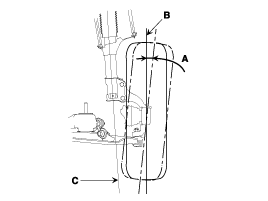Hyundai Tucson: Tires/Wheels / Alignment Repair procedures
Hyundai Tucson (LM) 2010-2015 Service Manual / Suspension System / Tires/Wheels / Alignment Repair procedures
| Front Wheel Alignment |
When using a commercially available computerized wheel
alignment equipment to inspect the front wheel alignment, always
position the vehicle on a level surface with the front wheels facing
straight ahead.
Prior to inspection, make sure that the front suspension and
steering system are in normal operating condition and that the tires are
inflated to the specified pressure. |
Toe

B - A > 0: Toe in (+)
B - A < 0: Toe out (-) |
Toe adjustment
| 1. |
Loosen the tie rod end lock nut. |
| 2. |
Remove the bellows clip to prevent the bellows from being twisted. |
| 3. |
Adjust the toe by screwing or unscrewing the tie rod. Toe
adjustment should be made by turning the right and left tie rods by the
same amount.
| |
| 4. |
When completing the toe adjustment, install the bellows clip and tighten the tie rod end lock nut to specified torque.
|
CAMBER

| ITEM | Description |
| A | Positive camber angle |
| B | True vertical |
| C | Strut centerline |
When the wheel tilts out at the top, then the camber is positive (+).
When the wheel tilts in at the top, then the camber is negative (-).
The stering knuckle which is installed with the strut
assembly is pre-set to the specified camber at the factory and doesn't
need to be adjusted.
If the camber in not within specification, inspect for damaged components and replace as needed.
Camber angle : -0.5°±0.5° |
CASTER
Caster : 4.05°±0.5° |

|
| Rear Wheel Alignment |
When using a commercially available computerized wheel
alignment equipment to inspect the rear wheel alignment, always position
the vehicle on a level surface.
Prior to inspection, make sure that the rear suspension
system is in normal operating condition and that the tires are inflated
to the specified pressure. |
Toe

B - A > 0: Toe in (+)
B - A < 0: Toe out (-) |
Toe adjustment
| 1. |
Loosen the nut holding the assist arm cam bolt (A). |
| 2. |
Adjust rear toe by turning the rear assist arm cam bolt (A)
clockwise or counter clockwise. Toe adjustment should be made by turning
the right and left cam bolt by the same amount.
| |
| 3. |
When completing the toe adjustment, tighten the nut to specified torque.
|
CAMBER

| ITEM | Description |
| A | Positive camber angle |
| B | True vertical |
| C | Strut centerline |
When the wheel tilts out at the top, then the camber is positive (+).
When the wheel tilts in at the top, then the camber is negative (-).
The stering knuckle which is installed with the strut
assembly is pre-set to the specified camber at the factory and doesn't
need to be adjusted.
If the camber in not within specification, inspect for damaged components and replace as needed.
Camber : -1.0°±0.5° |
 Wheel Repair procedures
Wheel Repair procedures
Hub nut tightening sequence
Tighten the hub nuts as follows.
Tightening torque (Front) :
88.25 ~ 107.9 N.m (9.0 ~ 11.0 kgf.m, 65.1 ~ 79.6 lb-ft)
Tightening torque (Rear) :
88.3 ~ 107.9 N.m (9 ...
Other information:
Hyundai Tucson (LM) 2010-2015 Service Manual: Input Speed Sensor Troubleshooting
Signal Waveform
Fig 1) Input/Output speed sensor at low speed
Fig 2) Input/Output speed sensor at high speed ...
Hyundai Tucson (LM) 2010-2015 Service Manual: Smart Parking Assist System Sensor Repair procedures
Removal
Front SPAS sensor
1.
Remove the front bumper.
(Refer to the BD group - "Front bumper")
2.
Pull out the SPAS sensor (A) by opening the sensor holder out.
3.
Disconnect the connector form the sensor.
Rear SPAS sensor
1.
Lift the vehicle up by using Remove the front bumper.
...
© 2010-2025 www.htmanual.net





